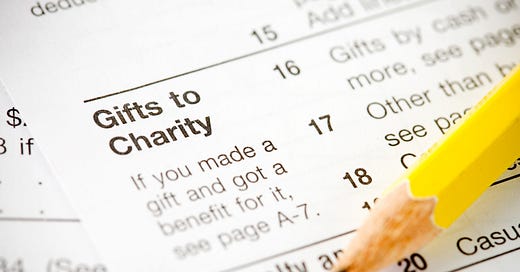New Floors and Ceilings on the Charitable Contribution Deduction
Researchers fear an overall decline in charitable giving as a result of BBB
The Big Beautiful Bill good news for charity is that starting in 2026, average taxpayers can once again take a deduction for charitable contributions. As a practical matter, the charitable contribution deduction is currently available only to the very wealthy — those with enough income and deductions that it makes better sense to itemize than to take the standard deduction. The standard deduction was significantly increased as part of the Tax Cut and Jobs Act. BBB, at Section 70102, not only increases the standard deduction — making it even less advantageous to itemize — but it allows a $1000 ($2000 for married couples) above the line charitable contribution deduction in Section 70424. It remains to be seen, however, if various floors and ceilings on the charitable contribution deduction will wipe out any increase in giving resulting from the above the line deduction.
In an article I published about 18 months ago, I argued that the effect of practically limiting the charitable contribution deduction to itemizers was that it provided wealthy taxpayers with a subsidy for charitable contributions that the rest of us did not enjoy. The wealthy already exercise undue influence over Civil Society precisely because they are wealthy. They should not be further advantaged by a deduction unavailable to the rest of us. The advantage and disadvantage to wealthy and average taxpayers, respectively, was undemocratic because it lessens grassroots influence over organizations that purport to extend democratic influence to regular folk. Reinstating the charitable contribution subsidy for regular folk, via an above the line deduction, lessens the relative advantage and disadvantage.
Still, observers are bemoaning the BBB’s predicted overall impact on charitable giving because of two floors and one ceiling. First, Section 70426 disallows the first 1 percent of corporate charitable contributions. In other words, corporations will be eligible for the deduction only to the extent the contribution exceeds 1% of taxable income. According to the Chronicle of Philanthropy, the typical corporation “gives slightly less than 1 percent of pre-tax profits.” An Ernst and Young study estimates that the 1% floor (combined with a 10% ceiling discussed below) will result in a decrease of between $4 and $5 billion in charitable contributions. Another provision, Section 70425, limits the deduction for individual itemizers to the amount that exceeds one half of one percent of a taxpayers modified AGI (i.e., the contribution base). As a general matter, floors present taxpayers with the choice of giving more than they might otherwise give or giving nothing at all.
Analysts assert also that new ceilings in the Tax Code will cost charities billions in charitable contributions. Section 10111 places a limit on the amount of itemized deductions available to [wealthy] taxpayers. Essentially, for each dollar of charitable contributions made, an itemizer can save no more than 35 cents. Under current law, the wealthiest donors save 37 cents. Thus, wealthy taxpayers will save less money under the BBB. Here is what a math and statics-heavy study (too heavy for me to understand or explain!) by the Lilly Family School of Philanthropy says about a new 35% ceiling on the value of itemized deductions:
We have calculated the estimated changes in itemized donations that would result from a tax deduction cap imposed on all deductions, including charitable donations, at 35%. This would only affect those who fall into the 37% marginal tax rate bracket (MTR). Given that the research literature has found a range of tax-price elasticities of demand, we have calculated the estimates for the decline in itemized charitable deductions using commonly assumed elasticities ranging from -0.5 to -2.0. Once adjusted for inflation to 2025 price levels, the lost charitable contributions range from approximately $2 billion (-0.5 elasticity) to $8.2 billion (-2.0 elasticity).
Finally, the 1% floor on corporate charitable contribution deduction is combined with a 10% ceiling. This means that only the amount between 1% and 10% of of taxable income will be deductible. The new law, at Section 70426, allows for a carryover of amounts in excess of 10% but as noted above, Ernst and Young estimates the floor and ceilings will decrease charitable giving by $4 to $5 billion.
A 2017 study by the Lilly foundation found that extending the charitable contribution deduction, as the BBB does, would likely increase charitable giving by 1.3% and 4.3%. I haven’t found a study yet that concludes that the increase will offset the decreases caused by the floors and ceilings discussed above. But the charitable sector would obviously prefer the above the line deduction be authorized without the floors and ceilings imposed on itemizers and corporations.




